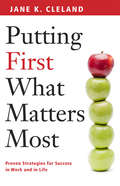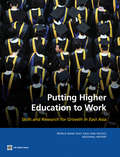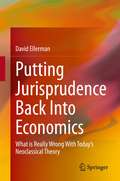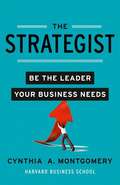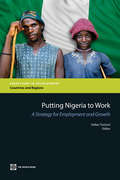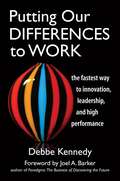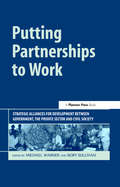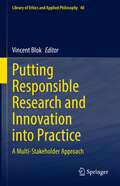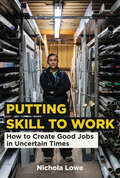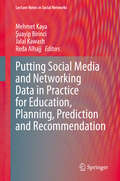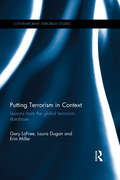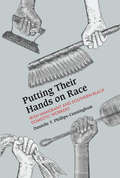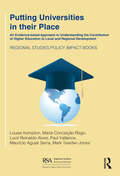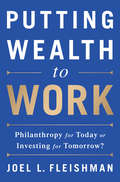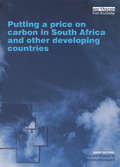- Table View
- List View
Putting Financial Intelligence to Work - Growing Your Business: Helping Your Entrepreneurial Venture Succeed
by Karen Berman Joe KnightMany entrepreneurs misunderstand the process of growth. They assume that it will take care of it itself - but, in reality, putting your company into a growth mode should be a conscious choice. This chapter discusses different paths to growth, and emphasizes how increasing your financial intelligence makes starting and running a company both easier and more rewarding. This chapter is excerpted from "Financial Intelligence for Entrepreneurs: What You Really Need to Know About the Numbers."
Putting First What Matters Most: Proven Strategies for Success in Work and in Life
by Jane K. ClelandJUGGLE MULTIPLE PRIORITIES WITH CONFIDENCEIf you feel as if you can&’t ever get caught up at work or in life—this book is for you! World-renowned speaker and author, Jane K. Cleland, shares proven priority-setting strategies and time management and communications tactics—ideas that you can customize for your own situation and put to work right away. Through fun and engaging assessments and exercises, you&’ll discover:• Step-by-step approaches to setting—and reaching—goals• How your personality affects your productivity and communication style• Where your strengths really lie—and how to capitalize on them• How to remain calm in a crisis by demonstrating true grace under pressure• A community of like-minded people—you&’ll read their inspirational stories and learn from their successes
Putting Global Logic First
by Kenichi OhmaeThe nation-state has begun to crumble. What is emerging in its place is the region-state, which is defined by economic activity, not political borders. The factors behind the shift are threefold: First, people, capital, and information can move across borders so quickly that economic decisions are often based on the fear that needed resources will go elsewhere. Second, as consumers see how other people live, they pressure their governments to give them access to the best and cheapest products. And third, as governments defer to special interests and try to provide constituents with a civil minimum of services, they invest inefficiently and as a result destroy wealth. Although political leaders will resist acknowledging the demise of the nation-state, only those who can accept it and promote region-states within and across their borders will be able to provide the best quality of life for their constituents.
Putting Higher Education to Work
by Shahid Yusuf Prateek Tandon Emanuela Di GropelloImpressive gains have been made in expanding access to higher education in East Asia over the past few decades, and the significance of higher education is expected to increase as developing economies face the challenge of sustaining growth in a competitive environment. Still, much work needs to be done if higher education is to realize its full potential to produce the skills and research needed for innovation and growth. “Disconnects” between higher education institutions and the skills and research users and providers they interact with—firms, research institutes, earlier education institutions, and other skill providers—have undermined the functioning of the subsector. In order for higher education institutions to be more responsive to the labor market, they should be better aligned with what employers and employees need and better connected among themselves and other skills providers. They also require stronger linkages with firms and other research providers to deliver research that can enhance innovation and productivity. Enacting policy reforms in the areas of financing, public sector management, and stewardship of the entire system will help the region achieve better skills and research outcomes and, ultimately, growth. Putting Higher Education to Work: Skills and Research for Growth in East Asia takes an in-depth and comprehensive look at higher education in East Asia—how it has changed, how it will continue to evolve, and how it can be improved. Using innovative firm surveys and the latest available evidence from the region, the authors identify functional skills needed for competitiveness and productivity, and look at how higher education systems can produce the type of skills and kind of commercially applicable research that will drive growth. Though focused on the developing countries in East Asia, the book’s methodologies, messages, and careful guidance will be of interest and value to researchers and policy makers in all regions where higher education and training are important issues. This book is the first title in the East Asia and Pacific Regional Report Series, a series that presents analyses of issues relevant to the region, drawing on the global knowledge and experience of the World Bank and its partners. This series aims to inform public discussion, policy formulation, and development practitioners’ actions, and thereby turn challenges into opportunities.
Putting Jurisprudence Back Into Economics: What is Really Wrong With Today's Neoclassical Theory
by David EllermanThis book presents an integrated jurisprudential critique of neoclassical microeconomic theory. It explains what is ‘really wrong’ with the theory both descriptively, as well as normatively. The criticism presented is based on questions of jurisprudence, and on neoclassical theory’s sins of omission and commission concerning the underlying system of property and contract. On the positive side - while the presentation is almost entirely non-mathematical - the book contains the first mathematical treatment of the fundamental theorem about property and contract in jurisprudence that underlies a market economy.The book follows the tradition of John Stuart Mill as the last major political economist who considered the study of property rights as an integral part of economic theory. The conceptual criticisms presented in this book focus on the descriptive and normative misconceptions about property and contracts that are deeply embedded ideology in neoclassical economics, not to mention in the broader society. The book recognizes that the idealized microeconomic theory is not descriptive of reality and focuses its criticism on conceptual mistakes in the theory, which are even clearer due to the idealized nature of the theory. Therefore, the book is a must-read for scholars, researchers, and students interested in a better understanding of jurisprudence in economics, neoclassical microeconomic theory, and political economy in general.
Putting Nigeria to Work: A Strategy for Employment and Growth
by Volker TreichelPublic debate in Nigeria on the country's progress since its return to democracy in 1999 has been dominated by two seemingly opposite themes. The first theme is the strong growth performance of the non-oil economy. This success has been marked by sharp increases in agriculture, trade, and construction and by the emergence of new industries in the financial, telecommunications, and entertainment sectors, supported by sound macroeconomic policies and structural reforms. The second, opposing theme is the seeming failure of Nigeria's much improved economic performance to reduce unemployment, especially among the young. Rising levels of unemployment have increased militancy among the young and impacted negatively on public order. 'Putting Nigeria to Work: A Strategy for Employment and Growth' looks at the ways in which Nigeria's improved economic performance has impacted the labor market. A number of relevant factors are carefully examined and analyzed, including industrial policy and the investment environment, the effects of restrictive trade policies on growth, and the ability of the technical and vocational education system to address the country's skills gap. The book proposes a strategy that will allow Nigeria to increase the availability of quality jobs, reduce rising youth unemployment, and sustain and further accelerate the country's economic performance and growth. At the core of this strategy are targeted interventions aimed at removing binding constraints to growth in sectors of the economy that are already growing fast, but have the potential to grow faster and have significant employment-creating potential.
Putting Our Differences to Work: The Fastest Way to Innovation, Leadership, and High Performance
by Debbe KennedyKennedy identifies five leadership practices that recognize differences generate new ideas and breakthrough thinking, and reframes how innovation, leadership, diversity, and inclusion connect to accelerate problem solving, team building, and decision making. Examples from both small and large companies illustrate a six step process for creating a diverse, inclusive environment that thrives on putting differences to work. Annotation ©2008 Book News, Inc. , Portland, OR (booknews. com)
Putting Partnerships to Work: Strategic Alliances for Development between Government, the Private Sector and Civil Society
by Michael Warner Rory SullivanThe World Summit on Sustainable Development in Johannesburg clearly identified the corporate sector as one of the key actors in the delivery of national and international poverty reduction targets in developing countries. "Partnerships" between government, civil society and business were proposed as one means whereby these poverty reduction targets were to be achieved. Despite the rhetoric, there was less consideration of how such partnerships could work in practice, the outcomes that could be achieved, or the relative merits of partnerships over other, more traditional approaches to development. This book is about partnerships between the private sector, government and civil society. Its objective is to share practical experiences in establishing and implementing such partnerships and to show how partnerships work. The focus is on the oil, gas and mining industries, as these sectors have tended to be the primary drivers of foreign investment in developing countries. These corporations increasingly operate in regions characterised by poor communities and fragile environments. The more effective use of external relationships to ensure the effective contribution of these investments to poverty reduction and local environmental management is critical, for the companies, for government, and for the poor. Putting Partnerships to Work is based on the work of the Secretariat of the Natural Resources Cluster (NRC) of Business Partners for Development (BPD). This major research programme, which ran from 1998 to 2002, aimed to enhance the role of oil, gas and mining corporations in international development. The programme objective was to produce practical guidance, based on the experience of specific natural resource operations around the world, on how partnerships involving companies, government authorities and civil-society organisations can be an effective means of reducing investment risks and of promoting community and regional development. The programme encompassed partnerships in Colombia, Nigeria, India, Venezuela, Bolivia, Zambia, Azerbaijan, Indonesia and Tanzania. The specific projects that were implemented included not only "traditional" development projects such as the provision of water, healthcare or infrastructure but also themes as diverse as conflict prevention, regional development, micro-enterprise development and managing oil spill compensation. Based on the experience of establishing and implementing effective partnerships, the NRC identified good practice, and developed replicable guidelines, tools and training materials. This book is not only about good practice; it presents both the positive outcomes and lessons from the programme, as well as the risks and costs, and where things went wrong. It also provides evidence not only of the viability of partnerships (i.e. that partnerships "can work") but also evidence that partnership approaches can provide substantially better outcomes for all parties than can more traditional approaches to development or corporate social responsibility. For example, a road in India was constructed at 25% of the cost to government; it took just 11 months for a community health centre in Venezuela to become operational and with its long-term financial future assured; and primary education enrolment rates in the vicinity of a gold mine in Tanzania have jumped from a historic level of 60–80% to almost 100% (as a consequence of improved infrastructure and community awareness of the importance of education). These development and public-sector benefits have been accompanied by substantial business benefits, including significant reductions in the cost of community development initiatives and/or the leverage of additional resources, greater sustainability and viability of development projects and significant improvements to corporate reputation and their local "social licence to operate" with communities. The book argues that to achieve these benefits requires all parties to invest time and effort in first exploring the best design for the partnership, unde
Putting Responsible Research and Innovation into Practice: A Multi-Stakeholder Approach (Library of Ethics and Applied Philosophy #40)
by Vincent BlokThis Open Access book builds on the experiences of one of the largest European projects in the domain of responsible Research and Innovation: NewHoRRIzon. It highlights the potential of and opportunity in responsible R&I to conduct innovation in a socially responsible way. Employing the methodology of Social Labs, the book analyses responsible R&I from an experience-based viewpoint and further explores the application of responsible R&I beyond scholarly and industrial interests. The contributors analyze the current European R&I landscape, provide reflection and reconceptualization of its core concepts, and project future challenges in relation to responsible R&I. The book complements the readers' line of work by providing insights on how responsible R&I can be applied by the audience, for example, in their decision-making processes.
Putting Skill to Work: How to Create Good Jobs in Uncertain Times
by Nichola LoweAn argument for reimagining skill in a way that can extend economic opportunity to workers at the bottom of the labor market.America has a jobs problem--not enough well-paying jobs to go around and not enough clear pathways leading to them. Skill development is critical for addressing this employment crisis, but there are many unresolved questions about who has skill, how it is attained, and whose responsibility it is to build skills over time. In this book, Nichola Lowe tells the stories of pioneering workforce intermediaries--nonprofits, unions, community colleges--that harness this ambiguity around skill to extend economic opportunity to workers at the bottom of the labor market.
Putting Social Media and Networking Data in Practice for Education, Planning, Prediction and Recommendation (Lecture Notes in Social Networks)
by Jalal Kawash Reda Alhajj Mehmet Kaya Şuayip BirinciThis book focusses on recommendation, behavior, and anomaly, among of social media analysis. First, recommendation is vital for a variety of applications to narrow down the search space and to better guide people towards educated and personalized alternatives. In this context, the book covers supporting students, food venue, friend and paper recommendation to demonstrate the power of social media data analysis. Secondly, this book treats behavior analysis and understanding as important for a variety of applications, including inspiring behavior from discussion platforms, determining user choices, detecting following patterns, crowd behavior modeling for emergency evacuation, tracking community structure, etc. Third, fraud and anomaly detection have been well tackled based on social media analysis. This has is illustrated in this book by identifying anomalous nodes in a network, chasing undetected fraud processes, discovering hidden knowledge, detecting clickbait, etc. With this wide coverage, the book forms a good source for practitioners and researchers, including instructors and students.
Putting Terrorism in Context: Lessons from the Global Terrorism Database (Contemporary Terrorism Studies)
by Gary LaFree Laura Dugan Erin MillerThis book offers a guide to interpreting available statistical data on terrorism attacks around the world. The Global Terrorism Database (GTD) now includes more than 113,000 terrorist attacks, starting in 1970. By analyzing these data, researchers demonstrate how a very small number of terrorist attacks have had an outsized effect on attitudes and policies toward terrorism. These attacks, referred to as ‘black swan’ events, are difficult to predict but have an enormous impact on human affairs for years to come. The book discusses terrorist attacks, such as 9/11, possibly the most high profile ‘black swan’ event in living memory, by putting them into context with thousands of less publicized attacks that have plagued the world since 1970. Historically, the study of terrorism has suffered from a general lack of empirical data and statistical analysis. This is largely due to the difficulty of obtaining valid data on a topic that poses significant collection challenges. However, this book makes use of the fact that the GTD is currently the most extensive unclassified database on terrorism ever collected. While there have been summaries of the research literature on terrorism and important analyses of international terrorism event data, this is the first book that provides a comprehensive empirical overview of the nature and evolution of both modern international and domestic terrorism. This book will be of interest to students of terrorism and political violence, criminology, international security, and political science in general.
Putting Their Hands on Race: Irish Immigrant and Southern Black Domestic Workers
by Danielle T. Phillips-CunninghamWinner of the 2020 Sarah A. Whaley Book Prize from the National Women's Studies Association Putting Their Hands on Race offers an important labor history of 19th and early 20th century Irish immigrant and US southern Black migrant domestic workers. Drawing on a range of archival sources, this intersectional study explores how these women were significant to the racial labor and citizenship politics of their time. Their migrations to northeastern cities challenged racial hierarchies and formations. Southern Black migrant women resisted the gendered racism of domestic service, and Irish immigrant women strove to expand whiteness to position themselves as deserving of labor rights. On the racially fractious terrain of labor, Black women and Irish immigrant women, including Victoria Earle Matthews, the “Irish Rambler”, Leonora Barry, and Anna Julia Cooper, gathered data, wrote letters and speeches, marched, protested, engaged in private acts of resistance in the workplace, and created women’s institutions and organizations to assert domestic workers’ right to living wages and protection.
Putting Universities in their Place: An Evidence-based Approach to Understanding the Contribution of Higher Education to Local and Regional Development (Regional Studies Policy Impact Books)
by Mark Tewdwr-Jones Paul Vallance Louise Kempton Maria Conceição Rego Lucir Reinaldo Alves Maurício Aguiar SerraThere have been several attempts in recent years to create conceptual frameworks and models to help universities and policy makers understand the role and contribution of higher education to local and regional development. However, these models have failed to fully reflect or give insufficient attention to the impact of the regional context (economic, social, political), the policy environment for higher education and territorial development and the diversity of management and leadership structures of universities themselves. This has led to the development of static models that rarely work outside of the immediate context in which they were developed and therefore risk leading to design of policies that are not fit for purpose. This Policy Expo is the result of work with partners in Europe, South America, Africa, Asia and Australia to develop a new approach, the ORPHIC Framework, to think about how the university can be adapted to the specificity of institutional and local contexts. The book examines: • What are the different roles that universities play in local and regional development and how do these manifest themselves? • How can we learn from comparing practice and experience internationally, and to what extent are policies aimed at promoting university–region relationships transferrable? • What are the internal university factors, such as management and leadership, history, mission, structures, and the external factors, such as territorial development policy context, governance system, nature of the ‘place’, that might help us explain the nature of the relationship?
Putting Wealth to Work: Philanthropy for Today or Investing for Tomorrow?
by Joel L. FleishmanBy 2025, Americans will likely be donating over half a trillion dollars annually to nonprofit organizations. Those philanthropic gifts will transform significant parts of America's civic sector landscape.Philanthropy is entering an era of unprecedented growth and innovation. Established foundations such as Ford and Rockefeller are doubling down on programs tackling long-simmering problems, including global inequality, less-than-stellar education, and uneven access to health care. Many foundations are engaging in advocacy on controversial issues, exploring venture philanthropy solutions, and experimenting with impact investing. And philanthropists such as Bill Gates, Warren Buffett, New York's high-profile financiers, and Silicon Valley's billionaires are planning to put their wealth to work as never before: Mark Zuckerberg and Priscilla Chan recently pledged to donate 99 percent of their Facebook shares during their lifetimes, and nearly 150 others have signed the Giving Pledge to increase dramatically their "giving while living."In Putting Wealth to Work, Joel L. Fleishman provides expert analysis of contemporary philanthropy, offering invaluable insight for those engaging with and affected by charitable foundations. This is the fascinating and definitive account of philanthropy today, and an indispensable guide to understanding its inner workings, impact, and expansive potential.
Putting Your Company's Whole Brain to Work
by Dorothy Leonard Susaan StrausInnovate or fall behind: The competitive imperative for virtually all businesses today is that simple. Responding to that command is difficult, however, because innovation takes place when different ideas, perceptions, and ways of processing and judging information collide. And it often requires collaboration among players who see the world differently. As a result, the conflict that should take place constructively among ideas all too often ends up taking place unproductively among people. Disputes become personal, and the creative process breaks down. The manager successful at fostering innovation figures out how to get different approaches to grate against one another in a productive process the authors call creative abrasion. Managers who want to encourage innovation need to examine what they do to promote or inhibit creative abrasion.
Putting Your Finger on Capability
by Clayton M. Christensen Tara DonovanPresents a model or theory about the competence or capability of organizations. Written to help managers be more precise about what the capabilities and disabilities of an organization are, and to be able to put their finger precisely on the place in the organization where capabilities and disabilities reside.
Putting a Price on Carbon in South Africa and Other Developing Countries (Climate Policy Ser.)
by Harald WinklerHow should we be putting a price on carbon, particularly in developing countries? This volume takes up this contested issue and examines how different economic instruments might apply in developing countries, with a special focus on South Africa. The papers included address a variety of themes in this area: Emissions trading, carbon taxes, fiscal and non-fiscal instruments, policy and institutional dimensions, and lessons from the Clean Development Mechanism. Presenting the very latest research, the volume will be of interest to academics and policymakers in economics, policy and development.
Putting the Balanced Scorecard to Work
by Robert S. Kaplan David P. NortonIn an earlier, groundbreaking article, Balanced Scorecard -- Measures That Drive Performance, the authors proposed a new measurement system that provided managers with a comprehensive framework to translate a company's strategic objectives into a coherent set of performance measures. Now the authors show how several companies are putting the balanced scorecard to work. Effective measurement, the authors point out, must be an integral part of the management process. Much more than a measurement exercise, the balanced scorecard is a management system that can motivate breakthrough improvements in such critical areas as product, process, customer, and market development. Several examples--Rockwater, Apple Computer, and Advanced Micro Devices--illustrate how the scorecard combines measurement and management in different companies. From the experiences of these companies and others, the authors have found that the balanced scorecard is most successful when it is used to drive the process of change.
Putting the Enterprise Into the Enterprise System
by Thomas H. DavenportDrawing on a rich set of company examples, Thomas H. Davenport, a professor at the University of Texas's Graduate School of Business, provides a fresh, high-level perspective on enterprise systems that will help senior executives think rationally about their large-scale investments in this technology. Enterprise systems present a new model of corporate computing. They allow companies to replace their existing information systems, which are often incompatible with one another, with a single, integrated system. By streamlining data flows throughout an organization, these commercial software packages, offered by vendors like SAP, promise dramatic gains in a company's efficiency and bottom line. It's no wonder that businesses are rushing to jump on the ES bandwagon. But while these systems offer tremendous rewards, the risks they carry are equally great. Not only are the systems expensive and difficult to implement, they can also tie the hands of managers. Unlike computer systems of the past, which were typically developed in-house with a company's specific requirements in mind, enterprise systems are off-the-shelf solutions. They impose their own logic on a company's strategy, culture, and organization, often forcing companies to change the way they do business. Managers would do well to heed the horror stories of failed implementations. FoxMeyer Drug, for example, claims that its system helped drive it into bankruptcy. Using examples of both successful and unsuccessful ES projects, the author discusses the pros and cons of implementing an enterprise system, showing how a system can produce unintended and highly disruptive consequences. Because of an ES's profound business implications, he cautions against shifting responsibility for its adoption to technologists. Only a general manager will be able to mediate between the imperatives of the system and the imperatives of the business.
Putting the Guiding Principles into Action: Human Rights at Barrick Gold (A)
by Rebecca M Henderson Nien-He HsiehIn 2010, Human Rights Watch, a well-regarded international NGO, approached Barrick Gold asserting that members of the company's security force at the Porgera Gold Mine in Papua New Guinea had on multiple occasions raped women who were trespassing onto the mine's waste dumps in search of gold. Subsequent investigations identified significant evidence to support the allegations, and the revelations led to broad ranging change at both Porgera and at Barrick more generally. Drawing heavily on the United Nation's Guiding Principles on Business and Human Rights (GPs), Barrick not only moved to make efforts to provide restitution to the women involved, but also designed and rolled out a comprehensive set of policies designed to embed the protection of human rights into the entire company. Barrick also played a central role in leading the development of an auditing and verification framework for the Voluntary Principles on Security and Human Rights (the VPs), a set of commitments embraced by most of the world's largest extractive companies. The case provides students with an opportunity to analyze the challenges that arise from operating in environments with weak state institutions; to examine the challenges of implementing voluntary frameworks, such as the GPs or VPs, and their potential as alternatives to state institutions; to learn about the field of business and human rights; and to develop an analytic framework for evaluating the responsibilities of business leaders to society, especially from the perspective of human rights.
Putting the Guiding Principles into Action: Human Rights at Barrick Gold (A)
by Nien-He Hsieh Rebecca M. HendersonIn 2010, Human Rights Watch, a well-regarded international NGO, approached Barrick Gold asserting that members of the company's security force at the Porgera Gold Mine in Papua New Guinea had on multiple occasions raped women who were trespassing onto the mine's waste dumps in search of gold. Subsequent investigations identified significant evidence to support the allegations, and the revelations led to broad ranging change at both Porgera and at Barrick more generally. Drawing heavily on the United Nation's Guiding Principles on Business and Human Rights (GPs), Barrick not only moved to make efforts to provide restitution to the women involved, but also designed and rolled out a comprehensive set of policies designed to embed the protection of human rights into the entire company. Barrick also played a central role in leading the development of an auditing and verification framework for the Voluntary Principles on Security and Human Rights (the VPs), a set of commitments embraced by most of the world's largest extractive companies. The case provides students with an opportunity to analyze the challenges that arise from operating in environments with weak state institutions; to examine the challenges of implementing voluntary frameworks, such as the GPs or VPs, and their potential as alternatives to state institutions; to learn about the field of business and human rights; and to develop an analytic framework for evaluating the responsibilities of business leaders to society, especially from the perspective of human rights.
Putting the Guiding Principles into Action: Human Rights at Barrick Gold (B)
by Rebecca M Henderson Nien-He HsiehSupplement to case 315108.

